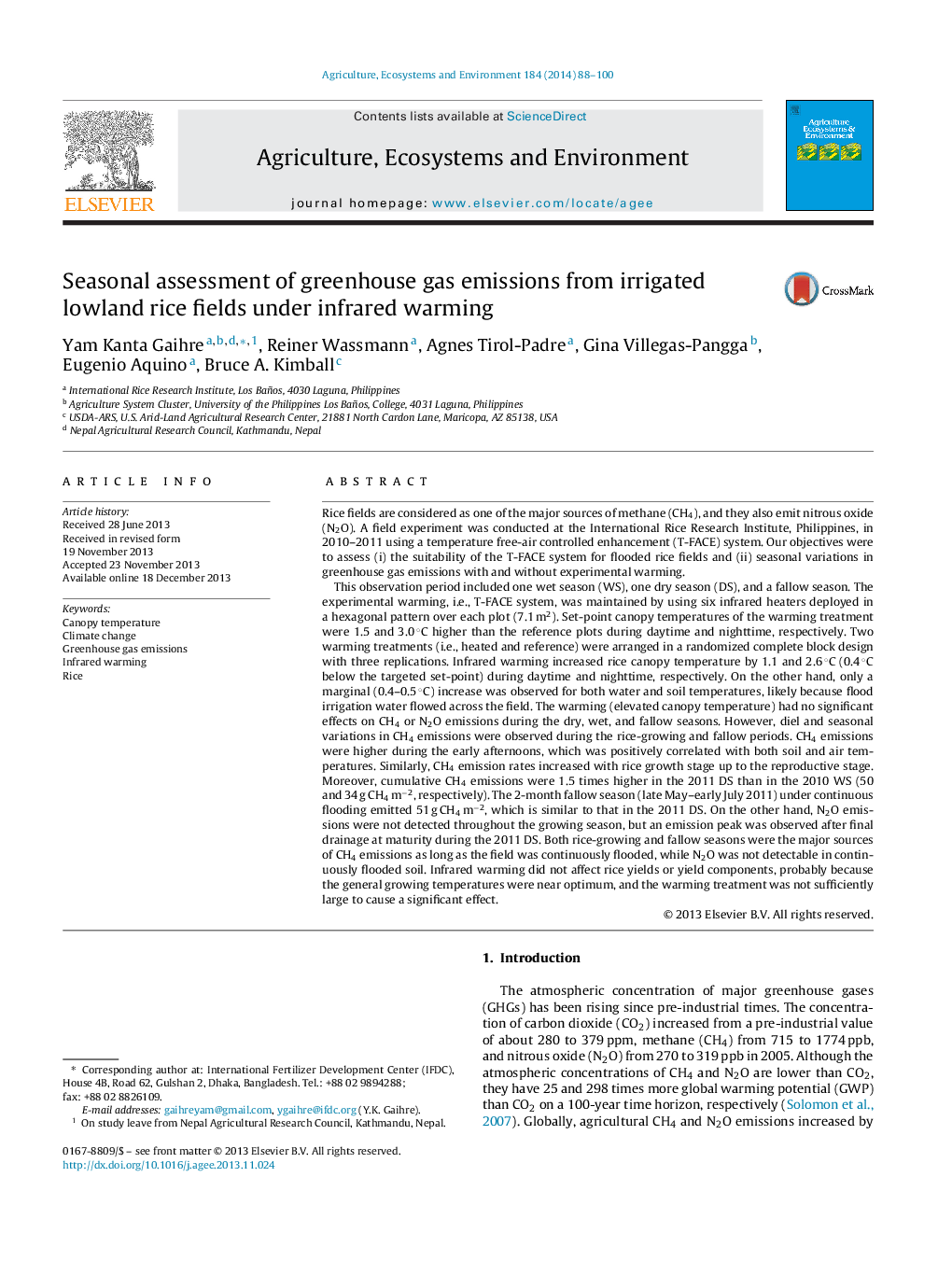| کد مقاله | کد نشریه | سال انتشار | مقاله انگلیسی | نسخه تمام متن |
|---|---|---|---|---|
| 8487954 | 1552068 | 2014 | 13 صفحه PDF | دانلود رایگان |
عنوان انگلیسی مقاله ISI
Seasonal assessment of greenhouse gas emissions from irrigated lowland rice fields under infrared warming
ترجمه فارسی عنوان
ارزیابی فصلی از انتشار گازهای گلخانه ای از مزارع برنج نیمه زمین آبی تحت گرم شدن مادون قرمز
دانلود مقاله + سفارش ترجمه
دانلود مقاله ISI انگلیسی
رایگان برای ایرانیان
کلمات کلیدی
دمای قایقی، تغییر آب و هوا، انتشار گازهای گلخانه ای، گرم شدن مادون قرمز، برنج،
موضوعات مرتبط
علوم زیستی و بیوفناوری
علوم کشاورزی و بیولوژیک
علوم زراعت و اصلاح نباتات
چکیده انگلیسی
This observation period included one wet season (WS), one dry season (DS), and a fallow season. The experimental warming, i.e., T-FACE system, was maintained by using six infrared heaters deployed in a hexagonal pattern over each plot (7.1 m2). Set-point canopy temperatures of the warming treatment were 1.5 and 3.0 °C higher than the reference plots during daytime and nighttime, respectively. Two warming treatments (i.e., heated and reference) were arranged in a randomized complete block design with three replications. Infrared warming increased rice canopy temperature by 1.1 and 2.6 °C (0.4 °C below the targeted set-point) during daytime and nighttime, respectively. On the other hand, only a marginal (0.4-0.5 °C) increase was observed for both water and soil temperatures, likely because flood irrigation water flowed across the field. The warming (elevated canopy temperature) had no significant effects on CH4 or N2O emissions during the dry, wet, and fallow seasons. However, diel and seasonal variations in CH4 emissions were observed during the rice-growing and fallow periods. CH4 emissions were higher during the early afternoons, which was positively correlated with both soil and air temperatures. Similarly, CH4 emission rates increased with rice growth stage up to the reproductive stage. Moreover, cumulative CH4 emissions were 1.5 times higher in the 2011 DS than in the 2010 WS (50 and 34 g CH4 mâ2, respectively). The 2-month fallow season (late May-early July 2011) under continuous flooding emitted 51 g CH4 mâ2, which is similar to that in the 2011 DS. On the other hand, N2O emissions were not detected throughout the growing season, but an emission peak was observed after final drainage at maturity during the 2011 DS. Both rice-growing and fallow seasons were the major sources of CH4 emissions as long as the field was continuously flooded, while N2O was not detectable in continuously flooded soil. Infrared warming did not affect rice yields or yield components, probably because the general growing temperatures were near optimum, and the warming treatment was not sufficiently large to cause a significant effect.
ناشر
Database: Elsevier - ScienceDirect (ساینس دایرکت)
Journal: Agriculture, Ecosystems & Environment - Volume 184, 1 February 2014, Pages 88-100
Journal: Agriculture, Ecosystems & Environment - Volume 184, 1 February 2014, Pages 88-100
نویسندگان
Yam Kanta Gaihre, Reiner Wassmann, Agnes Tirol-Padre, Gina Villegas-Pangga, Eugenio Aquino, Bruce A. Kimball,
